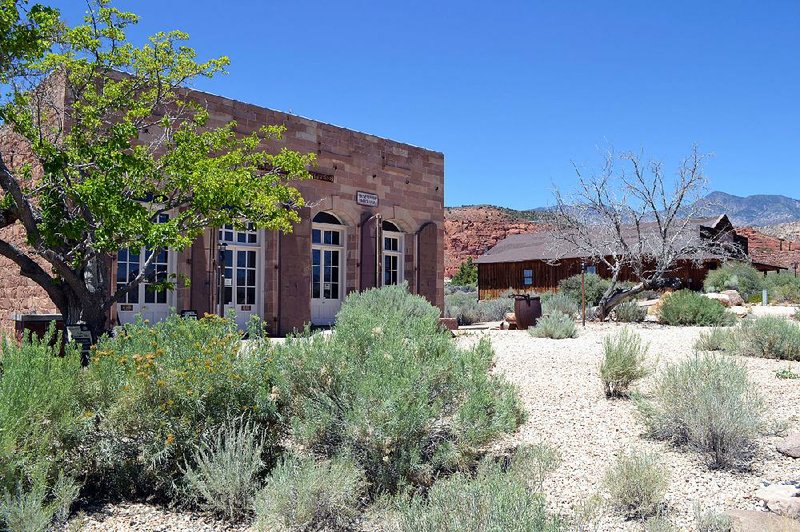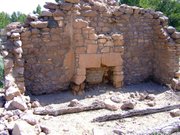Here, in the desert, nothing moves. Nothing but the dust in the wind.
The occasional lizard, snakes, probably scorpions and the wind are the only inhabitants of the places I am seeking in the desert. Because in these places, it is the ghosts of the American West who hold forth.
Rhyolite, Nev.: Heading north on U.S. 95 from Las Vegas, travel 116 miles to Beatty, Nevada’s gateway to Death Valley National Park. Rhyolite is four miles west of Beatty on Nevada 374 and is overseen by the Bureau of Land Management. Info: nps.gov/deva/learn/…
Goldwell Open Air Museum: You’ll come to the museum just before you get to Rhyolite. The art is accessible 24/7; the visitor center, which has some history of Rhyolite, a small guide for 50 cents, plus beautiful handmade flutes for sale by center overseer Richard Stephens, is open most days from 10 a.m.-4 p.m. except Sundays. Info: goldwellmuseum.org.
Silver Reef, Utah: The ghost town is 18 miles north of St. George. From Las Vegas or St. George take Interstate 15 north to Exit 22 toward Utah 228/Leeds. Take that 0.7 mile and turn left onto Silver Reef Road (it becomes Oak Grove Road) and just past Juniper Way, turn right on Wells Fargo Road, which takes you to the ghost town. The Wells Fargo Express Building Museum offers guided tours at 10:30 a.m. and 1 and 3 p.m. during regular hours, 10 a.m. to 5 p.m. Monday and Thursday-Saturday; $3 per person or $10 per family. Info: silverreefutah.org.
Old Iron Town, Utah: From Cedar City, head west on Utah 56 for approximately 20 miles. Turn south onto Old Iron Town Road and go south for approximately 5 miles to the ruins. The park service recommends visitors first stop at the Frontier Homestead State Park Museum in Cedar City to get an overview of the area’s history and to pick up a self-guided tour brochure. Old Iron Town is open year-round during daylight hours. Info: frontierhomestead.o…, (435) 586-9290.
Not the average creepy individual ghosts -- though you may find those here, too.
These are the ghosts whose skeletons are the crumbled bones of buildings, whose headstones are the signs bleached to illegibility by the sun. The spirits here are not of individuals, but of humanity in general, from its hopes and dreams to its greed and folly.
These are the phantoms of places, of history that have come to be known as ghost towns.
All were places once booming, places the dreamers moved heaven and earth to get to. They came for a treasure, a mother lode, an impossibility made true. On a rumor, through the grapevine, at great peril to life and limb, they came. Pioneers, lone men, hard men, with determination or nothing left to lose, who came and laid claims, and picked up shovels and planted dynamite. Lives and fortunes played out in accelerated real time, but the heydays were numbered. The hard times may have taken decades, but more often only years, to draw to swift and disastrous ends.
That's when the people -- the bankers, the paupers, the ladies of the night and the families who believed their futures would always be bright -- saw the end looming. They left in droves.
These towns are the ghosts of boomtowns past.
There are ghost towns everywhere. But the American West is where you'll find those quintessentially busted boomtowns.
Some have gotten a second wind as tourist attractions; others remain "Hey, look at that!" places occasionally stumbled upon by the lost. Many have been tarted up again, with signs and souvenirs, while others remain virtually untouched -- except by the wind, the occasional rain and the sweep-swish whisking of the sidewinder.
So I rented a car and headed out, along interstates that went from traffic jams to better-carry-water-in-case-I-get-stuck-or-I'll-die-before-someone-finds-me; that went from 65 mph limits to 70 and then 75 and then 80 (would have taken photos as evidence, but was driving too fast); that went from neon billboards advertising casinos and Penn & Teller to big yellow lettered store signs for Area 51 Cafe decorated with aliens.
I knew that I was getting close. The wind picked up. The ghost towns were waiting at the end of the road.
RHYOLITE, NEV.
The most common instigator in the boom-to-bust-to-ghost-town evolution is the mother lode.
Contrary to the name, Rhyolite, about 120 miles northeast of Las Vegas at the eastern edge of Death Valley National Park, was not established to unearth the eponymous mineral. Rhyolite was just the most common mineral miners hit while extracting gold (and some silver) in this godforsaken part of Nevada. As one local explained it, "Rhyolite was what the miners swore at."
Two wandering miners, Shorty Harris and Ed Cross, are credited with making the find on Aug. 4, 1904, when they noticed an errant piece of quartz with rhyolite and flecks of gold.
"The quartz was just full of free gold," Shorty said. "Talk about rich! Why, gee whiz, it was great."
Mining began in earnest in 1905. Industrialist Charles M. Schwab got a piece of the action early on and invested heavily in infrastructure, including piped water, electric lines and railroad transportation. By 1907, Rhyolite had electric lights, water mains, telephones, newspapers, a hospital, a school, an opera house and a stock exchange. But the boom began to bust quickly after the San Francisco earthquake and fire in 1906 began drying up the pool of excited investors. By 1911 mining was over.
Rhyolite was once the biggest town in southern Nevada. Today it's a pretty extensive ghost town. It is a relatively popular tourist draw. Not like it's swarming with humanity. I probably saw two dozen people all day. But it was harder to catch that all-alone-with-ghosts-of-miners-past feeling than, say, my first and truly eerie encounter decades earlier at the one-shack-plus-snakes town of Bumble Bee, Ariz.
As the day wound down, and I got thirstier, and the dirt and pebbles and rocks and old pillars of the once-mighty bank cast longer and longer shadows, and the people in their convertibles snapped their last images and drove off in search of cold beers and hot showers, I got some alone time.
Notable features: The ruins are extensive, with a bank, miners shacks, print house, mercantile shop, etc. The train depot (privately owned) and the Bottle House are entirely intact. The bottle house, yes, was built almost completely of actual bottles -- 51,000 beer bottles cemented with adobe mud. It was restored by Paramount Pictures in January 1925 for a movie, The Air Mail.
Before you get to the ghost town, you'll find Goldwell Open Air Museum, a pretty cool collection of seven large sculptures -- most notably a ghostlike Last Supper.
SILVER REEF, UTAH
It took a while to find Silver Reef. It's 18 miles north of St. George, which happens to be a big town in western Utah. The area today is vast vistas of sandstone in red and gray, worth the drive even if you never did find the little ghost town that sits at the end of a development of tony houses at the end of a quiet residential road.
Quite a different scene from the one 150 years ago, after John Kemple, a prospector from Nevada, discovered a vein of silver in a sandstone formation in 1866. It is one of only two places on earth where silver was found in sandstone, and for a while nobody believed the silver was real. It was, and there was enough of it to generate this particular flash in the pan boomtown, which lasted seven years before its fortunes began to decline.
Notable features: There's a museum, as well as the Cosmopolitan Restaurant, restored to a more or less original version from the 1870s.
The ruins are surrounded by and interspersed among modern upscale houses, and even the rather crazy-looking studio/art gallery of bronze sculptor Jerry Anderson. The scenery has made this area a magnet for artists, and several communities in the area offer galleries and studio tours.
OLD IRON TOWN, UTAH
About 25 miles west of Cedar City, down an increasingly lonely Utah 56 and then 5 miles down Old Iron Town Road are the fenced-in ruins of this former boomtown. Originally called Iron City, the ghost town was begun by Brigham Young, the head of the Mormons, who realized that the fastest way to an independent Mormon state was to make the new colony self-sufficient. An important factor in this plan was iron, which was very expensive to ship from the eastern United States. The operation was set up to take advantage of nearby Iron Mountain.
At its height, Old Iron Town had a schoolhouse, a furnace, an arastra for grinding fine sand for molds, a blacksmith shop, a general store, charcoal kilns and cabins for its workers. It was a productive effort, but several obstacles, including a lack of transportation, led to its abandonment after seven years, in 1876.
Iron Mountain remains one of the richest iron deposits in the country.
Notable features: Preservationists decided to leave the ruins in their natural state. Visitors will see the blast furnace chimney, ruined walls of the foundry, the arastra, a charcoal kiln and a cabin. The beehive kiln is impressively intact. Though off the beaten track, the site has bathrooms and a picnic area. There are also two short hikes through the ruins and the desert.
Nearby is the old pioneers cemetery in Little Pinto. And on your way to Snow Canyon -- definitely worth a visit for its stunning, poured-rock-looking lava formations -- is Mountain Meadows, site of the 1857 massacre of the Fancher Party Wagon Train by local Mormon settlers. There are memorials to the victims off Utah 18.
Online: ghosttowns.com; freepages.history.rootsweb.ancestry.com/~gtusa/usa.htm
Travel on 11/22/2015

